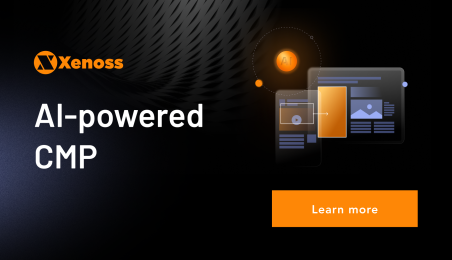To preserve the ROI of campaigns that are swiftly losing addressability and decrease creative production costs, marketers increasingly leverage AI-powered creative management platforms (CMPs).
Managing the digital advertising sprawl manually is no longer sustainable. To successfully leverage omnichannel campaigns, agencies and in-house marketing teams need an up-to-date toolset for cross-platform creative optimization and a unified dashboard for campaign management and analytics.
MarketWatch reveals that the creative management platforms market is projected to grow from $865 million in 2022 to $1,770 million by 2027. This lucrative market has one critical caveat: CMP platforms are incredibly hard to develop and integrate with the ecosystem. Modern CMPs are data-intensive solutions that require high-load and ML expertise in their development.
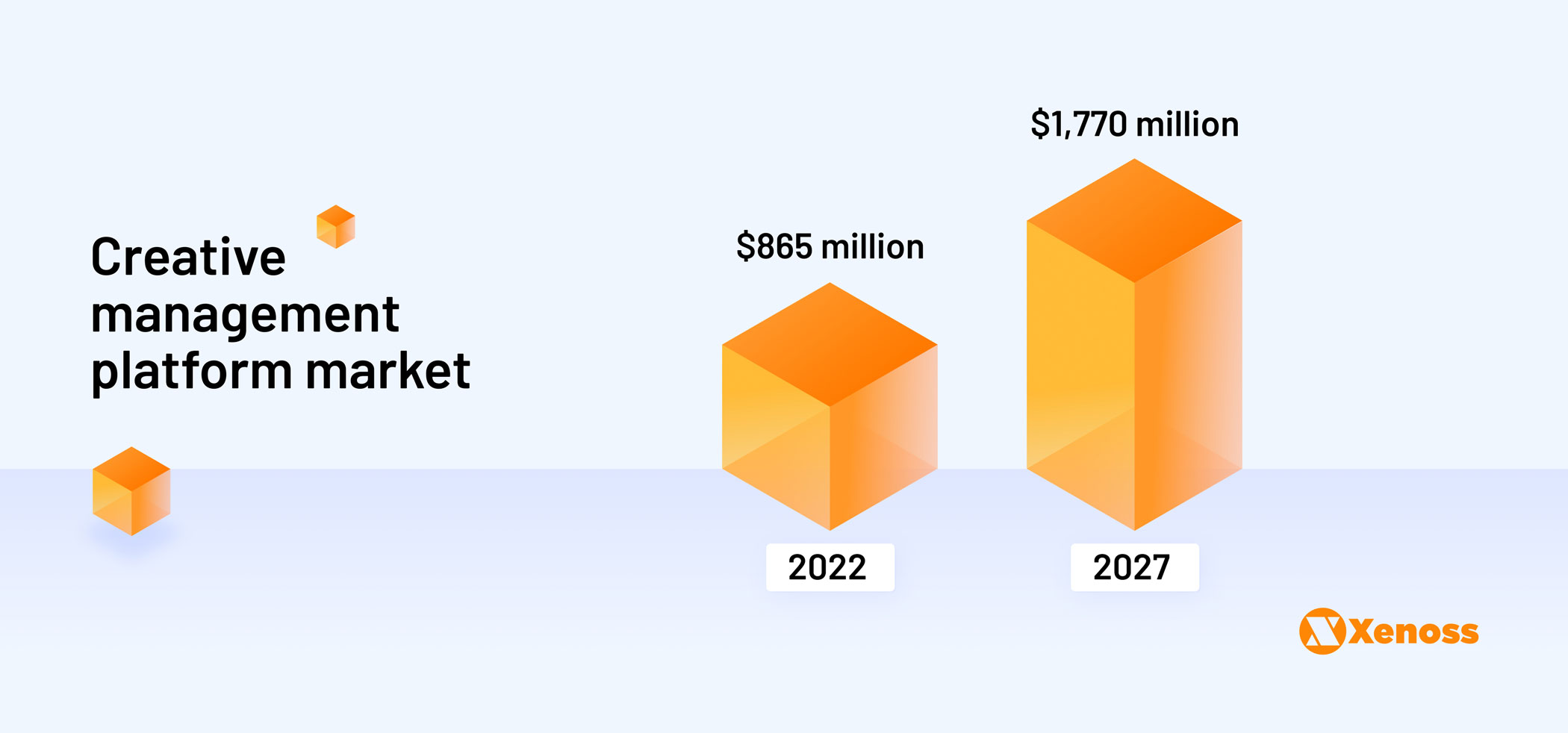
In this article, we’ll take a look under the hood of creative management platforms and answer the following questions:
- What is a creative management platform and why is it gaining popularity?
- What do brands and agencies appreciate most in CMPs?
- Who are the key market players in the CMP market?
- What features make a CMP competitive?
- What are the bottlenecks of CMP development and what is the best way to address them?
What is a creative management platform?
A creative management platform (CMP) is a cloud-based software solution that helps manage digital advertising campaigns. With a CMP, marketing teams create, design, distribute, and scale ads, while making changes on the fly according to performance insights empowered by ML.
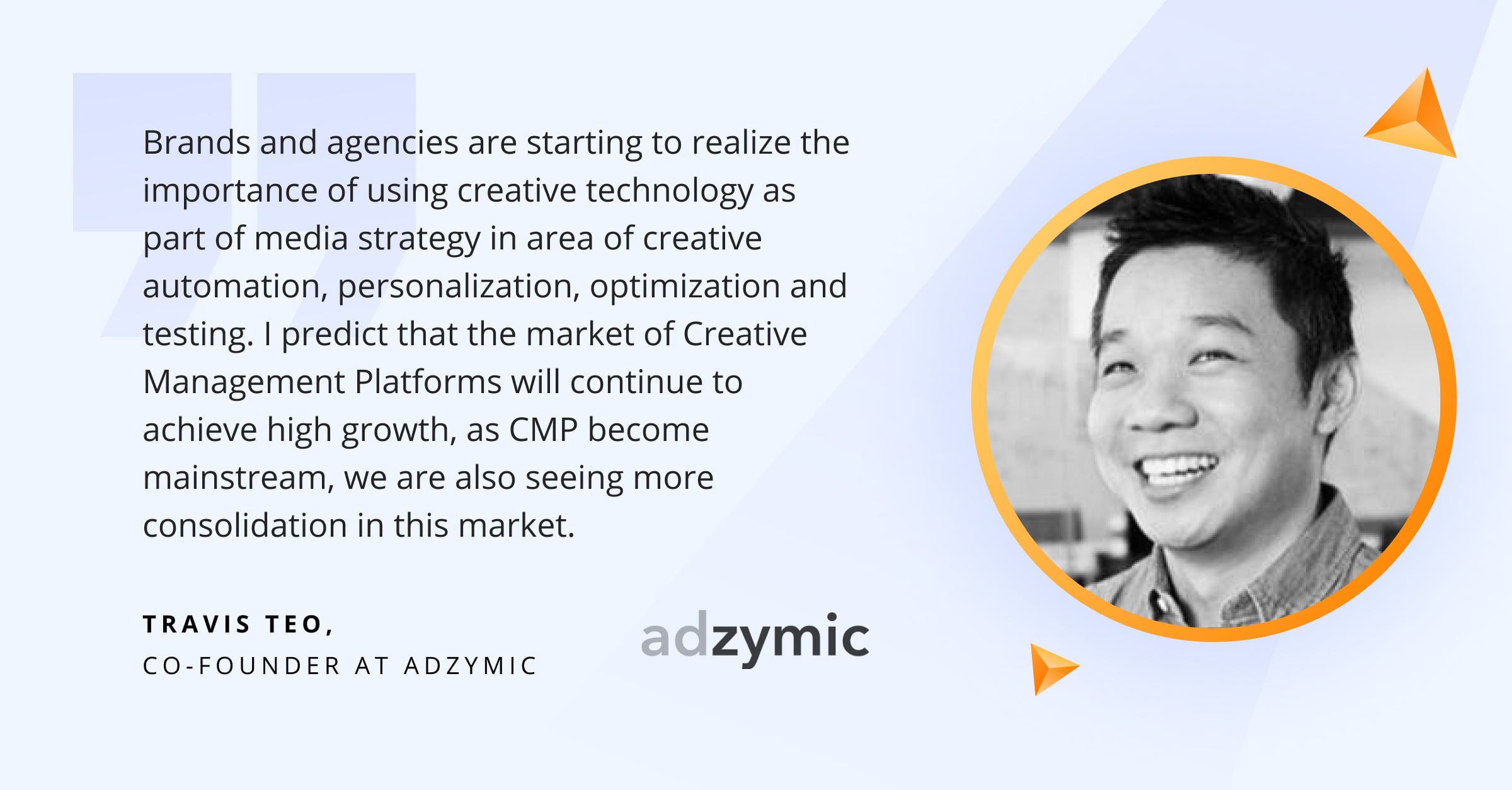
Let’s check the basic principles about how a CMP works.
At the first stage, the user uploads files with ad materials in a format of images, video, or HTML to the platform. A CMP produces a master creative and scales it to different ad sizes and formats. An image recommendation engine and AI tools for editing give the user more control over the process.
At the second stage, crafted ads are published on Facebook, YouTube, Google, and other advertising platforms — in a few clicks, from one dashboard, without the need for the user to leave the platform.
At the third stage, a reporting CMP’s module retrieves ad campaign data. When metrics are collected, a CMP adjusts creatives for better performance and predicts ad fatigue with an ML model.
Finally, the campaigns can be re-launched and the cycle repeats itself.
Creative management platforms enable companies to automate processes and reduce ad creative production time. According to Bannerwise, CMP can save 90% of time spent on ad creative production and distribution.The possibility of reducing time spent on digital ad production is the icing on the cake though. Let’s check what else has provoked the widespread adoption of CMPs.
Why CMPs are gaining popularity
Emerging advertising platforms (e.g., TikTok, CTV ad platforms, retail media solutions) force advertisers to juggle multiple ad channels. The CMPs help them to conduct omnichannel campaigns, optimize and publish thousands of creatives, while keeping creative production costs low.
The important role of CMPs has been reinforced because of the swiftly changing AdTech landscape. Changes involve tightening privacy rules:
- Looming phase out of third-party cookies
- Introduction of AppTrackingTransparency (ATT) framework
- Evolving data privacy legislation
New privacy regulations alter the mechanics of advertising: Brands have to switch from the addressable and targetable audiences to anonymized cohorts of users. They enter the gray area of heightened uncertainty. Getting through this phase and reaching the target audience with a high degree of personalization requires advanced creative optimization. Advertisers need to catch the slightest data correlation, apply A/B tests and dynamic creative optimization, all of which can be achieved with a CMP.
Benefits of CMPs for brands and agencies
Here are the reasons why in-house marketing teams and agencies are utilizing creative management platforms more and more.
Automation of advertising campaigns
A unique engine for template automation like that implemented by Celtra allows for building templates without being overwhelmed by specific coding or design tasks. Brands can create numerous static and dynamic ads and optimize them on the fly across different channels and formats.
Efficient scaling
CMP features streamline ad production and distribution processes. Translation models help to swiftly cater to multilingual audiences. Сomputer vision understands frames in the video and adapts creatives to different channels. For example, the Xenoss team leverages computer vision within projects for image and video processing to find the key components of ads, determine the most efficient ones, and reuse them in other creatives.
Reducing creative production time and costs
Using one dashboard to produce and publish thousands of creatives within a short time creates commercial benefits for the companies — they lower creative production costs, gain better control and visibility of marketing campaigns, and preserve brand consistency by opting for the right combination of language, colors, and graphic elements in their ads.
Real-time performance analysis
AI trained on ad performance data can identify falling engagement or other issues with the CTR, quality score, CPC, conversions, bounce rate. CMPs analyze data and generate accurate insights that enable marketers to level up advertising campaigns and preserve budgets.
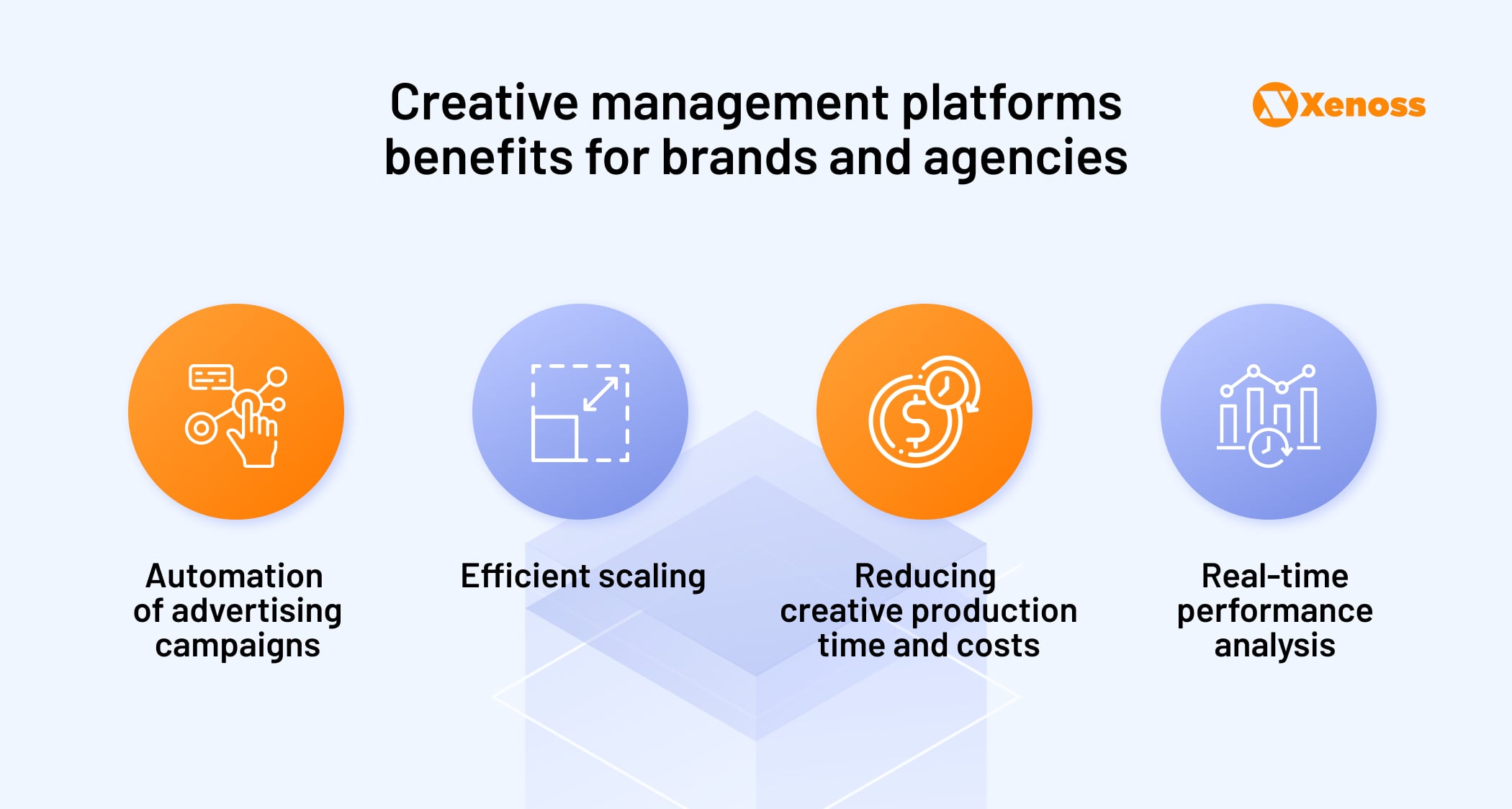
Best creative management platforms
After elaborate research that included investigation of G2 Grid, SaaSWorthy, Gartner Reviews and Ratings, and other ratings, combined with our consideration of interesting features of various CMPs, we’ve come up with the ultimate list of creative management platforms with outstanding capabilities.
Celtra
Celtra offers a suite of creative automation solutions for advertising and marketing teams. Their CMP provides design and animation features, including smart image cropping, that helps create unique templates and facilitate ad production. Users can generate hundreds of banners, images, and videos in minutes. Through APIs, this CMP distributes campaigns to social, video, media, email, and other channels.
The prominent feature is a central content repository, which is separated from design, so that users don’t open design files to update messaging or CTA. Celtra is used by such well-known enterprises as Shopify, Spotify, NBCU, Adidas, Unilever, etc. With Celtra’s CMP at their disposal, companies deliver a brand’s message and scale ads to enhance targeting and measurement capabilities.
Ad-Lib.io
Ad-Lib.io is an omnichannel platform built around DCO and analytics technology. The platform helps brands manage and personalize creative assets at scale. Xenoss has been the company’s tech partner in developing the AI-powered creative management platform. Our team built a market-ready MVP in 4 months, implemented cost-efficient scalable infrastructure, and connected Ad-Lib.io to numerous advertising platforms for omnichannel ads distribution.
Advanced capabilities powered by predictive algorithms and reusable templates make the platform appealing to renowned brands. Adidas, Uber, Coca-Cola, Shell, TUI, and Pepperstone craft and distribute their targeted digital messages with Ad-Lib.io.
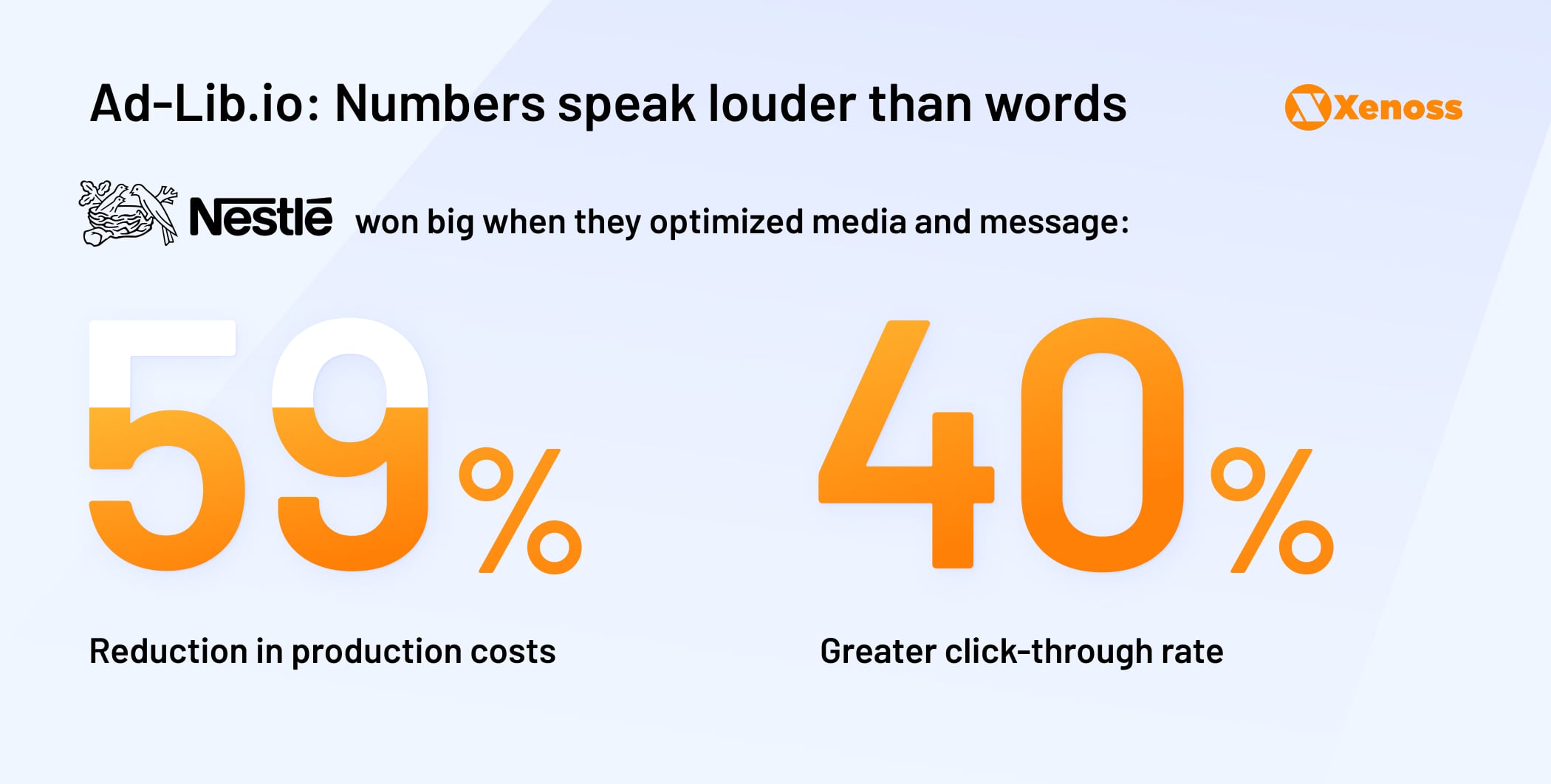
Smartly.io has recently acquired Ad-Lib.io. Great teams are joining forces to map out and design an even stronger solution for marketers. The nascent creative management platform can simplify building relevant ads across channels and offer teams advanced collaboration capabilities.
Adobe Advertising Cloud
Adobe Advertising Cloud is a programmatic advertising platform that facilitates omnichannel campaigns. It helps manage search, CTV, video, mobile, audio, and other types of ads and automate creatives across all screens and media channels.
Teams leverage this tool for various purposes. Hagerty paired Adobe Advertising Cloud with Adobe Analytics and cut spend for campaigns by 45% and cost-per-click by 10.4%. Allianz uses the platform to improve ad search performance, reach existing audiences, and find new clients. With Adobe Sensei, an AI component that analyzes data and patterns, all these companies easily optimize marketing campaigns and directly link them to the goals.
VidMob
VidMob, a platform for creative intelligence, helps create and manage ads across channels. Actionable insights allow VidMob users to make informed decisions and scale creative production. Among partners of VidMob, you can find Google, Hulu, Reddit, Meta, Youtube, and many other prominent brands.
Vidmob offers templates to automatically generate creatives based on the product feed data. Actionable insights enable teams to optimize creative performance and increase ROAS, ROI, CTR, and VTR.
Adzymic
Adzymic is a dynamic creative management platform that assists agencies and brands in improving the performance of advertising campaigns. This CMP helps craft rich media creatives via ready-to-use-templates and conduct cost-efficient ad campaigns.
By leveraging ML algorithms, Adzymic can analyze impressions to optimize programmatic buys. This CMP connects with DSPs and ad servers to make buying strategy and campaign tracking more flexible. Among brands who work with Adzymic, we see big names like Mercedes, SAP, IKEA, and Harvey Norman.
As a proprietary solution, Adzymic offers Smart Feed. It enables advertisers to automatically update product ads. Smart Feed crawls an advertiser’s website to auto generate product feed based on the product pages. After that, this product feed can be integrated into third-party channels and marketplaces.
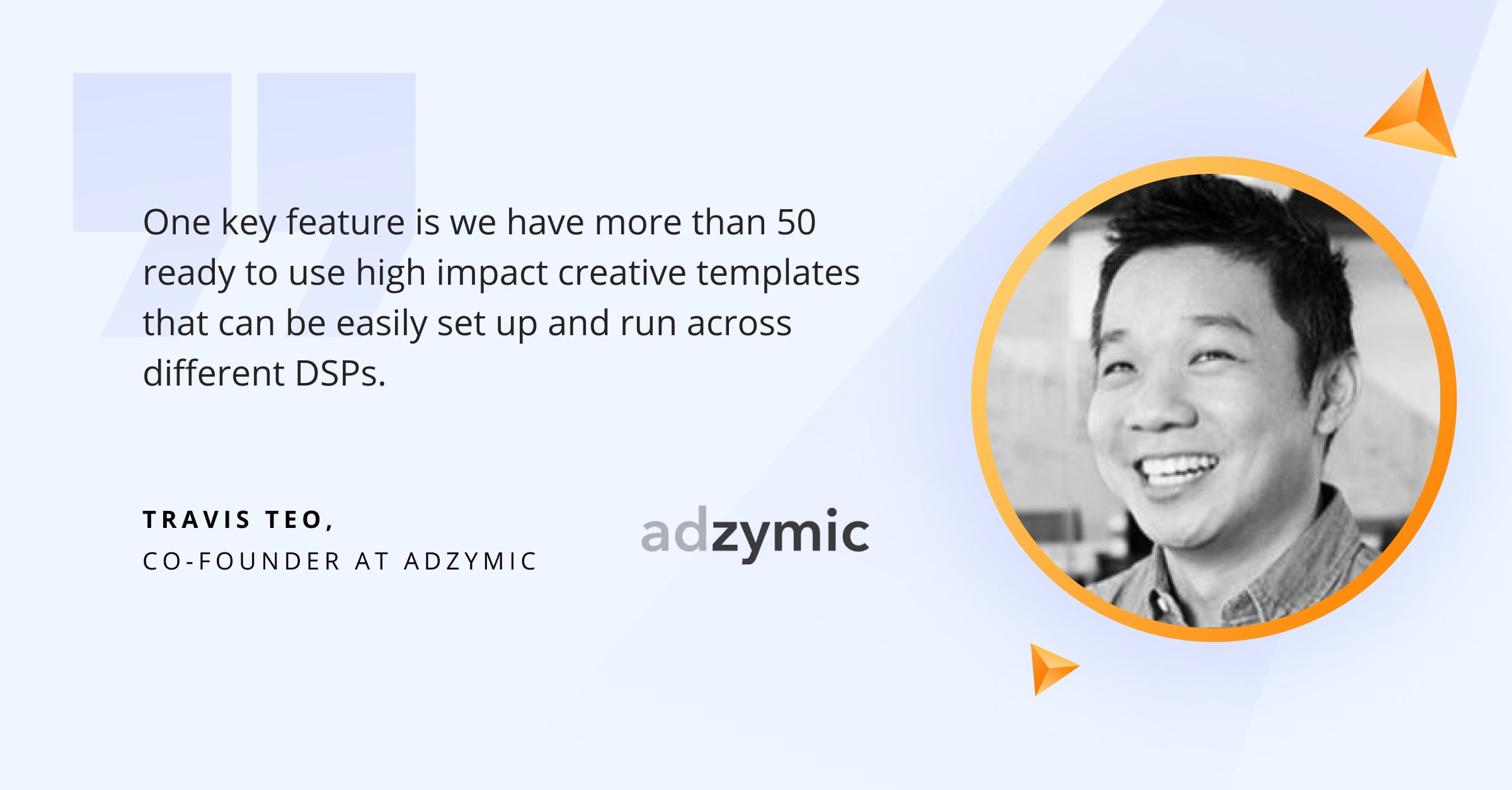
Bynder
Bynder is a creative management platform that streamlines the advertising process by helping teams manage digital assets. In the heart of Bynder’s CMP lies the Dynamic Asset Transformation engine. When connected to the advertiser’s ecosystem, it automates asset optimization.
The notable Bynder’s feature is setting the focus of the image to automatically crop it and produce relevant creatives. In addition, this CMP has prebuilt integrations, including those for distributing and tracking assets. The Compact View, which is embedded in the platform, enables users to search and import assets into other applications.
AdCreative.ai
As an AI-powered creative management platform, AdCreative.ai allows for building data-backed creatives to increase conversion rate and improve CTR. AdCreative.ai detects pain points of the target audience and builds creatives aligned with that data.
The platform supports the creation of ads, texts, headlines, and social creatives, while granting user access to insights. Through this data-driven approach, AdCreative.ai proposes up to 14x higher conversion rate and easily integrates with Google, Facebook, Zapier, and other platforms.
Marin Software
Marin Software is a creative management platform with advanced reporting and analytics modules. It facilitates management of ad campaigns and assists in budget allocation. With Marin Software, brands smooth the customer journey, analyze the insights produced by ML, and enhance publisher’s tools they’re already using.
The platform brings together different features for creation and distribution of creatives, among which the important role is assigned to a budget optimizer. It monitors campaign expenditures and adjusts them to the plan, sending alerts if the campaign has gotten close to over or under spending.
Bannerflow
Bannerflow is a creative management platform that powers omnichannel campaigns. This CMP produces ads in different formats: HTML5, jpg, png, mp4, and gif. In 2022, Bannerflow-made ads generated 118 billion impressions.
These ads power marketing campaigns and can be reviewed and improved on the spot. As a result, brands benefit from personalized advertising campaigns with low costs and high ROI. On top of that comes the direct publishing feature: The Banneflow platform has integrations to 20+ ad servers, DSPs, and ad networks, where users can publish ads in one click. HP, Shutterstock, Storytel, and Telia trust Bannerflow to automate their creative production.
Ultimate CMP features
To stay competitive, a creative management platform needs to have a number of inbuilt features that will help marketers conduct efficient ad campaigns, from building creative assets from templates, dynamic creative optimization, to automated optimization, and ML-powered analytics.
Xenoss’ accumulated tech expertise in development and improvement of creative management platforms helps us outline the list of ultimate CMP features. Let’s have a look.
Ad creator
Ad creator generates creatives and optimizes them to each media channel. It involves ready-to-use templates and formats. Users don’t need any coding skills to leverage an ad creator and automate creative production.
Adobe Express offers a powerful ad creator for smooth ad production and delivery. It enables marketers to create ads from blank canvas while using stunning templates and personalizing with their own creative materials. A creative for one platform, like Google, can be easily transformed into ads for Twitter or Instagram.
Scaling module
Any large-scale dynamic creative campaign, where ads have to be relevant and personalized, requires hundreds of pixel perfect creatives. A scaling module is responsible for the mass ads production and optimization to the network where these ads will be published. This module optimizes file size so that ads comply with the networks’ requirements.
The Bannerwise CMP offers a scaling module that builds a coherent set of ads from the master creative. Users can edit creatives of all sizes simultaneously or separately, set up, and leverage custom templates.
Publishing tool with network integration
Integration with Google, Facebook, Snapchat, Twitter, and TikTok as well as other ad networks helps creative management platforms to hit lists of the best providers. This feature caters to marketing teams whose activity involves intensive ad publishing and who seek to create resultative campaigns while cutting off production costs and time.
For example, Celtra‘s publishing tool enables marketing teams to easily export and distribute to social, video, display, email, and other ad channels.
Cloud-based collaboration module
Creative management platforms foster teamwork, helping to generate creatives simultaneously and collaborate in a user-friendly environment while having permanent access to all materials that are stored in the cloud.
Even though deploying CMPs in the cloud – Google Cloud, Microsoft Azure, AWS, Amazon EC2, Salesforce Heroku – is a common practice, collaboration and engagement opportunities of creative management platforms may differ. CMPs with a shared content repository and creative operations connected to project management tools are flourishing SaaS solutions right now.
AI-powered analytics
Real-time metrics, analysis of user journey, and dynamic creative optimization are fueled by AI – all these elements increase the platform efficiency in reaching the target audience. Ad-Lib.io leverages ML models to automatically identify attention catchers and crop images for cross-channel ad campaigns.
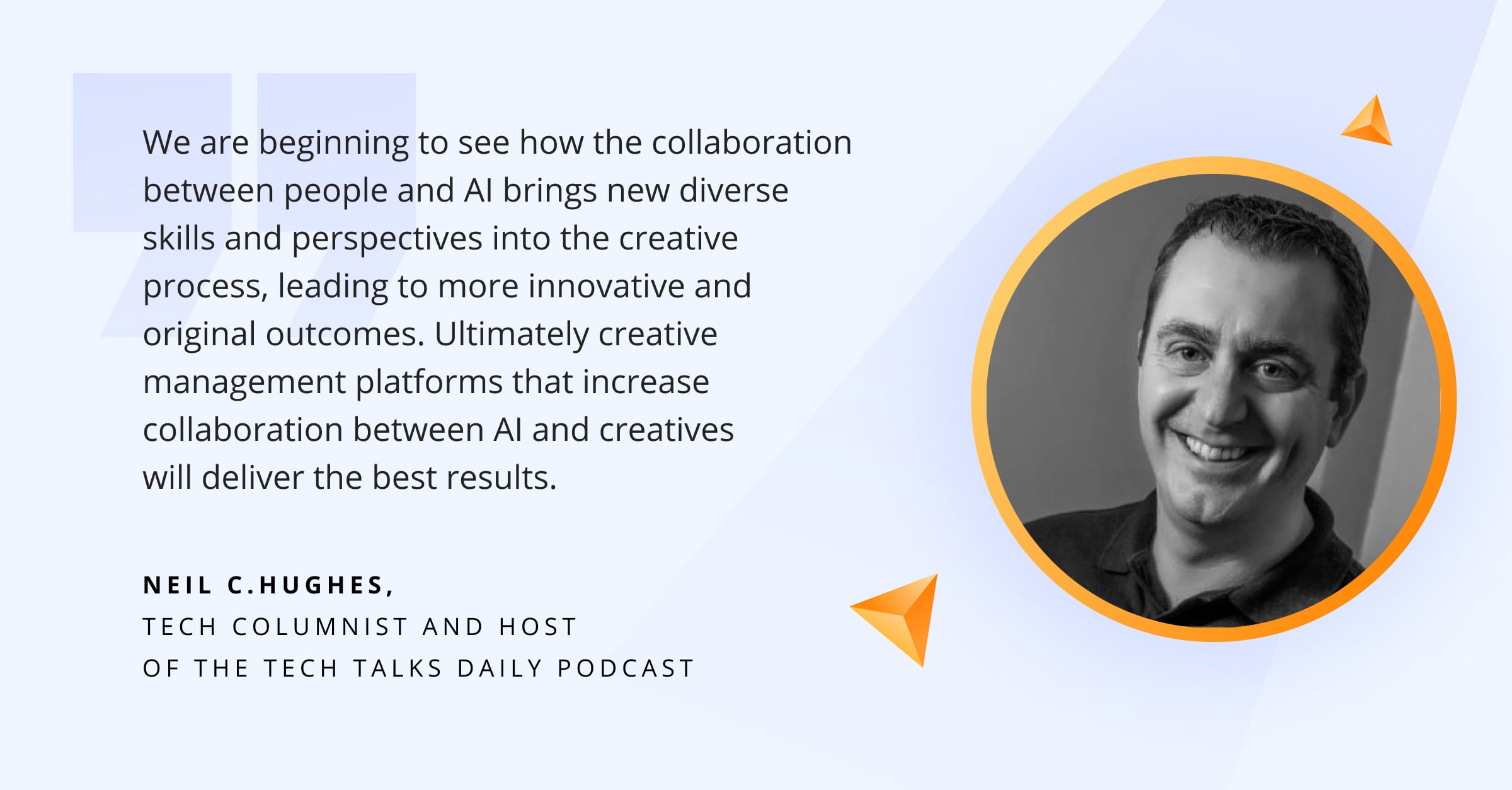
A/B testing and auto-optimization
This module allows teams to compare ad strategies and change variables like text, image, or video. Moreover, with A/B testing and auto-optimization, designers spend less time scrutinizing data related to ads performance, being able to automate advertising processes.
Zeta Marketing platform utilizes real-time performance insights to optimize creatives. Continuous A/B testing and leveraging AI allow this CMP’s users to tune ad messages, gain better performance, and improve ROI.
Translation management
Worldwide targeting as well as selecting particular areas for conducting marketing campaigns may be difficult. Marketers are treading treacherous waters when adapting campaigns to different markets. CMPs can remove the pain of translating with a translating management module that simplifies workflows and collaboration between translators and designers.
Integration of translated copy into ad banners helps to see it into context and make a sound decision on its relevance and improvement. CMPs with a translation management module will help to get rid of repetitive tasks and automatically adjust text to the master creative.
Landing page builder
Creative management platforms with a landing page builder allow for testing ideas, audience, and interest in products and events. By creating landing pages, CMPs ensure fast time to market and significantly contribute to successful lead generation.
Bannerflow offers a landing page builder for running personalized marketing ad campaigns across industries from healthcare to hospitality.
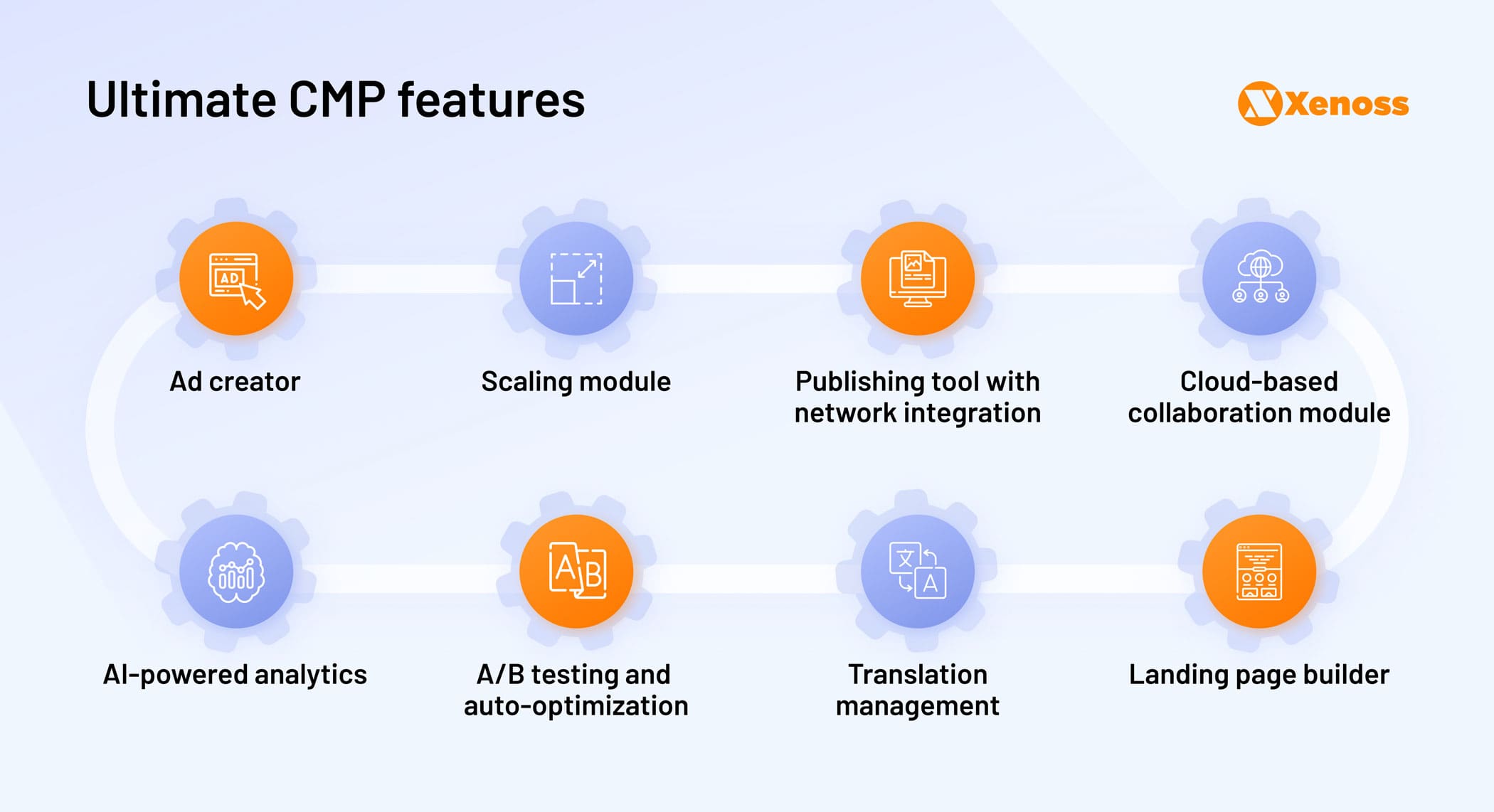
Tech challenges to consider when developing a creative management platform
CMP development can be a tough nut to crack. Having built multiple creative management platforms, the Xenoss team is ready to share its insights. We have transformed the experience into a clear guide, describing what specific tech bottlenecks CMP vendors will face and how to address them.
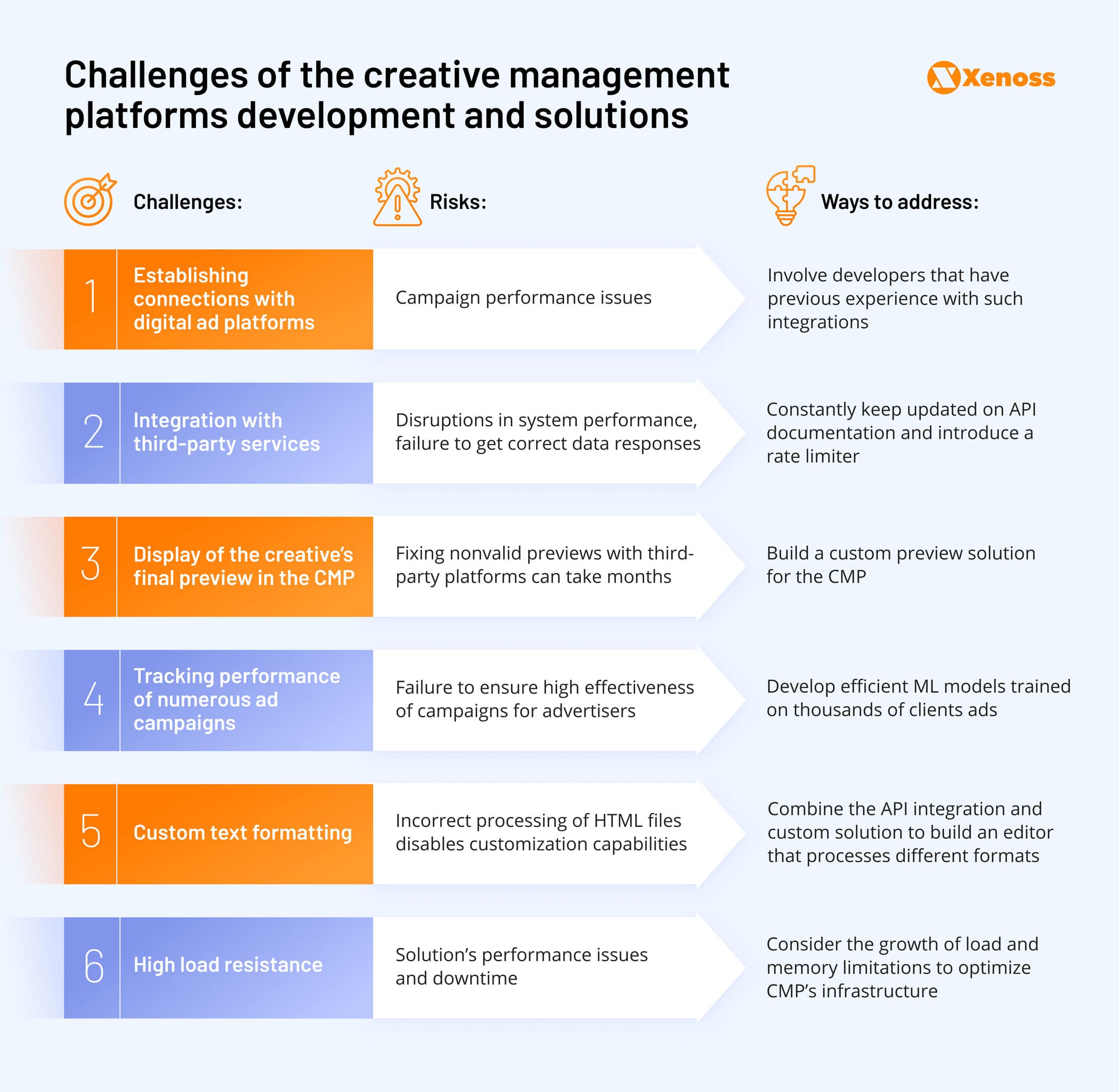
Challenge 1: Establishing connections with digital ad platforms
The evolving AdTech market imposes new requirements for the engineering teams that develop creative management platforms. Engineers need to have relevant experience working with Meta Business Manager, Ads Manager, YouTube Advertising, Google Campaign Manager, Amazon Ads, and other ad dashboards. Establishing connections with digital advertising platforms is required for managing ad serving, targeting and permissions, tracking budgets, and retrieving data about campaign performance.
Potential risks
Without in-depth expertise in AdTech tools, the tech specialists spend more time on API integrations and may fail to consider all factors while connecting the CMP to digital ad platforms. This may cause significant disruptions in ad delivery and even stop the ads from showing.
Ways to address
There are two approaches to the development of a creative management platform. The first approach involves devoting more time to onboard engineers and getting them up to speed on the recent AdTech developments (in-house experts should be involved in that case). Alternatively, you can hire a seasoned team with deep expertise in developing AdTech solutions. Only engineers with the relevant experience will be able to solve these problems effectively and efficiently the first time.
Challenge 2: Integration with third-party services
CMPs communicate with third-party services to store assets, publish creatives, extract analytics, and perform other operational tasks. For a CMP’s flawless performance, the development team should maintain the system in accordance with third-party service documentations at all times and handle limits and quotas on data requests.
Potential risks
Apart from publishing channels, a CMP may have integrations with attribution partners, CRMs, image storages, etc. A poorly performed integration risks getting incorrect data responses. Additionally, failing to meet the requirements of third-party services for load management can cause an overall disruption of the CMP.
Ways to address
The solution is to always keep track of API documentation and rapidly respond to any changes. You should establish a process helping the team control new updates on a regular basis and systematically update your platform.
Additionally, it’s crucial to proactively address limits and quotas on API requests.
To illustrate, let’s look at Google limitations. Limits in Campaign Manager 360, Google Drive, and Google Sheets restrict the maximum number of requests. This measure shields the infrastructure from an overload. For example, when using Google Sheets API, you should stay within the per-minute quotas: 300 Read requests per minute per user and 300 Write requests per minute per user.
Implementation of a rate limiter in a CMP allows for controlling the flow. When users exceed the limits, the request will be sent after the shortest period of time, as soon as a new quota is provided.
Challenge 3: Display of the creative’s final preview in the CMP
Users want to preview creatives on different devices and screen sizes to understand how their ad will look when published on Facebook, Instagram, Twitter, or other networks. Retrieving data – the preview of creatives – from third-party platforms can be an obstacle that interrupts the user experience.
Potential risks
There are deeply rooted operating features and processes inherent in platforms, on which the CMP’s engineering team has no impact. For example, Facebook can send back a nonvalid preview or not send it at all. In this case, engineers must contact support service and make their own suggestions about the problems. Resolving the ticket by the Facebook support team may take a few months. In the meantime, the functionality of the CMP along with the user experience suffer as marketers are flying blind with their creatives.
Ways to address
An engineering team must be able to connect the dots: Implement and support features required by the client without being stuck because of the third-party service. Therefore, implementation of the custom preview service can be a reasonable solution here. Previews gained through the custom service need to accurately reflect how the future creative images, videos, or HTML banners will look.
To generate previews of video or HTML banners, CMPs can rely on the tools to render creative (like Adobe After Effects), iframe, and screenshot services.
It works like this: A user uploads an HTML banner to the platform and gets access to functionality for changing color background and transforming separate elements. When the changes are applied, the user submits them by clicking a button.
At that moment, the script emits an event and transmits data to the iframe. To correctly display the preview of the creative in the iframe, a CMP integrates with a third-party service that takes screenshots to convert HTML into static images.
Challenge 4: Tracking performance of numerous ad campaigns
Tracking hundreds of campaigns manually to detect poor performance of ads is inefficient, even impossible in some cases. Companies must not only collect meticulous analytics from ad platforms but also leverage ML models to make sense of the vast pool of data.
Potential risks
Without extensive performance tracking functionality, advertisers won’t achieve the results they expect. ML models in a CMP analyze real-time audience behavior and enable efficient optimization of ad campaigns. They can reveal failing performance and send instant notifications to users in charge. However, ML for the sake of ML has very little value and meaning. ML implementation is often an expensive and resource-intensive venture.
To track ad performance efficiently, ML models should be trained on thousands of clients’ ads, which require a solid data management strategy. Generating and training these models require data science and MLOps capabilities, and may not run smoothly for companies without this expertise.
Ways to address
Businesses don’t often understand that to train ML you need large amounts of quality data. On top of that, you need the infrastructure to support the processing and analysis of this data. Before you even consider ML, you must first analyze the trade-offs between time and money invested and the value you will gain.
Training models for a CMP can be riddled with unexpected challenges. Campaign performance can significantly fluctuate depending on the weekday or other seasonalities, confusing the models with outliers.
Developing a reliable ML model requires substantial training. A time honored solution from our practice is to give an ML model for CMP sufficient time to assess tendencies and introduce a 2-week constant for ads analysis.
Challenge 5: Custom text formatting
Creative management platforms need to produce different variations of the ads based on the user input. To create ad variations, they leverage the custom text formatting feature. Its implementation is complicated and can be carried out in three different ways: integration with a third-party service, development of a custom solution, or combining both these strategies.
Potential risks
The greatest difficulty is custom formatting based on the uploaded HTML file. It has to be transformed into text, with the ability to change color, size, or background. If HTML is processed wrong, customization capabilities will be disabled.
Ways to address
To resolve this challenge, a CMP requires the combination of the API integration and custom solution. With custom text formatting, users can easily change the look and content feeling of creatives.
Challenge 6: High load resistance
An engineering team working on a CMP needs to consider load fluctuations. It’s crucial to capture load management issues and troubleshoot them as fast as possible to avoid disruption of the marketing campaigns.
Potential risks
Seasonal advertising campaigns with a surge in the number of creatives cause load fluctuations. Rendering of 30,000—40,000 creatives makes a creative management platform a high load project that requires a scalable design. If the architecture of the CMP can’t cope with load, it will cause performance issues.
Ways to address
The team involved in the CMP development needs to consider the exponential growth of load and memory limitations.
On Black Friday, Christmas, or other days that mark major shopping activity, retailers run large advertising campaigns. The general number of creatives could reach 50,000 and exceed the memory and data processing limitations.
To future-proof the platform, consider the peak load, which the system must be able to handle, and prepare the technology accordingly. Moving to microservice architecture and optimizing the platform’s infrastructure can greatly benefit the products.
Takeaway
Creative management platforms assist brands and agencies in streamlining advertising campaigns and optimizing creative production spend. As the market becomes saturated, CMPs need to up their game with versatile functionality.
As customers give preference to flexibility, there will be no universal tech-savvy solutions among creative management platforms. Consequently, there will always be a niche for a CMP that solves the problem of the specific industry or closes the tech gap for certain types of enterprises.
If you need to develop an AI-powered creative management platform or implement sought-after features into the CMP, feel free to drop us a line – we will consult with you on options and handle code-heavy processes.

